17th-Century William and Mary Olive Oyster Chest of Drawers on Stand
1690 England
SOLD
Request Information
Follow Us
17th-Century William and Mary Olive Oyster Chest of Drawers on Stand
A superb example of well-chosen hand-cut olive oyster veneers, combined with the finesse of a highly skilled craftsman, from the reign of William & Mary (1689-1702).
The rectangular top with moulded edge inlaid with holly stringing depicting scrolls, heart shapes and
• Highly intricate inlaid top inlaid with holly stringing.
• A sunburst of
• Holly roundels to the drawers surrounding drop handles.
• Cross grain mouldings throughout.
• Two short asymmetric drawers and two long graduating drawers above the original stand drawer.
• Period locks.
• Possibly later olive ash legs and olive cross grain veneered stand on bun feet.
• Fabulous colour and richly patinated throughout.
Condition
Provenance
Literature
Literature: ‘Early English Furniture 1660-1714’ by Adam Bowett
Dimensions
PREVIOUSLY SOLD
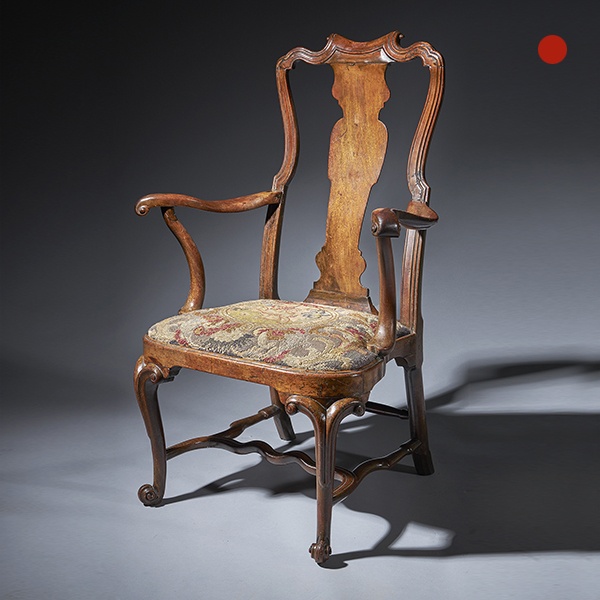
An extraordinary George I walnut armchair Circa 1725, England
An extraordinary George I walnut armchair of fabulous colour, form and patination. The chair is of the most lively shapes being either carved or turned.

A fine burr walnut George I dressing mirror. Circa 1715-25 England.
A fine burr walnut George I dressing mirror Circa 1715-25 England. SoldFollow UsA fine burr walnut George I antique dressing mirror An extremely rare and fine George I burr walnut dressing mirror raised on ball and bracket feet. The drawer...
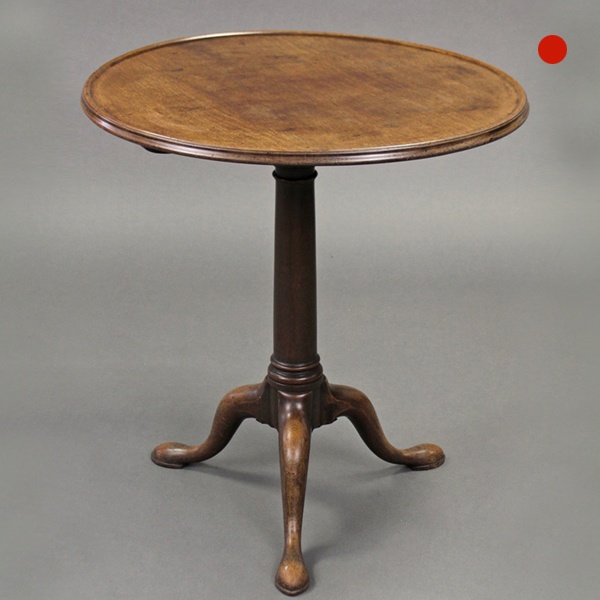
George III Mahogany Gun Barrel Tray Top Tripod Table Sofa Table Chippendale Period
A George III Mahogany Gun Barrel Tray Top Tripod Table, Sofa Table, Chippendale Period, circa 1770-1790, England. The circular tray top with moulded edge is raised on a gun-barrel centre column and cabriole legs with shaped pad feet.

George III Chippendale Period Mahogany Pie Crust Tray
A fine George III Chippendale period mahogany pie crust tray, circa 1770, England. Of circular form, with a carved and shaped edge. Alexander George Fine Antique sell 18th & 19th century antique English furniture.
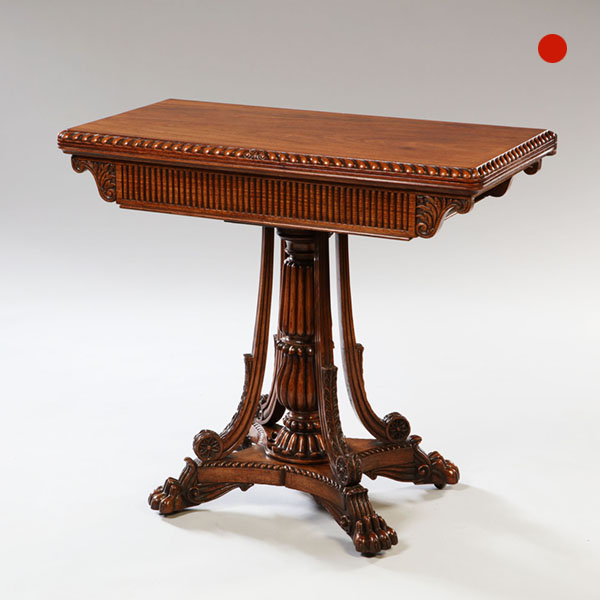
Solid Padauk Carved Anglo-Indian Card Table
Solid Padauk Carved Anglo-Indian Card Table. With the growth of trade and military power, the East India Company encouraged its British male employees to create a community with mixed ancestry. The company paid 15 silver rupees to the mother of any child born of such marriages.

William and Mary Kingwood or ‘Princes’ wood oyster cabinet on chest
When the most expensive timber of the 17th century met Thomas Pistor. There were, in fact, two cabinet-makers called Thomas Pistor, father and son, working for a period at the same time but at different premises. One or both are known to have made furniture of quality for Levens Hall.

An extraordinary George I walnut armchair Circa 1725, England
An extraordinary George I walnut armchair of fabulous colour, form and patination. The chair is of the most lively shapes being either carved or turned.

A fine burr walnut George I dressing mirror. Circa 1715-25 England.
A fine burr walnut George I dressing mirror Circa 1715-25 England. SoldFollow UsA fine burr walnut George I antique dressing mirror An extremely rare and fine George I burr walnut dressing mirror raised on ball and bracket feet. The drawer...

George III Mahogany Gun Barrel Tray Top Tripod Table Sofa Table Chippendale Period
A George III Mahogany Gun Barrel Tray Top Tripod Table, Sofa Table, Chippendale Period, circa 1770-1790, England. The circular tray top with moulded edge is raised on a gun-barrel centre column and cabriole legs with shaped pad feet.

George III Chippendale Period Mahogany Pie Crust Tray
A fine George III Chippendale period mahogany pie crust tray, circa 1770, England. Of circular form, with a carved and shaped edge. Alexander George Fine Antique sell 18th & 19th century antique English furniture.

Solid Padauk Carved Anglo-Indian Card Table
Solid Padauk Carved Anglo-Indian Card Table. With the growth of trade and military power, the East India Company encouraged its British male employees to create a community with mixed ancestry. The company paid 15 silver rupees to the mother of any child born of such marriages.

William and Mary Kingwood or ‘Princes’ wood oyster cabinet on chest
When the most expensive timber of the 17th century met Thomas Pistor. There were, in fact, two cabinet-makers called Thomas Pistor, father and son, working for a period at the same time but at different premises. One or both are known to have made furniture of quality for Levens Hall.
YOU MAY ALSO LIKE
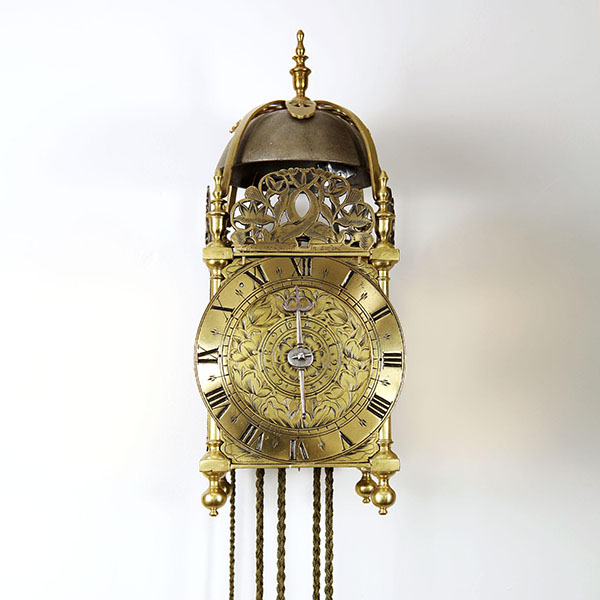
17th Century Lantern Alarm Clock by Johannes Quelch, Oxford
17th Century Lantern Alarm Clock by Johannes Quelch, Oxford £14,000Follow Us17th Century Lantern Alarm Clock by Johannes Quelch, Oxford An English 17th century lantern clock made of brass and iron, circa 1665-1670. The clock consists of going...

19th-Century Flame Mahogany Mantel Clock by BREGUET Raised by Lion Paw Feet
19th-Century Flame Mahogany Mantel Clock by BREGUET Raised by Lion Paw Feet £23,500Follow Us19th-Century Flame Mahogany Mantel Clock by BREGUET Raised by Lion Paw Feet EXTREMELY RARE MANTEL CLOCK WITH A FIGURED MAHOGANY-VENEERED CASE by A-L...

Unusual Pair of 18th Century George III Cherry Chairs, Chippendale Period
Unusual Pair of 18th Century George III Cherry Chairs, Chippendale Period £3,900Follow UsUnusual Pair of 18th Century George III Cherry Chairs, Chippendale Period A fabulous and rare pair of George III cherry wood chairs in original 'Country...

Unusual Ribbed Eight-Day Repeating Striking Gilt-Brass Gorge Case Carriage Clock
Unusual Ribbed Eight-Day Repeating Striking Gilt-Brass Gorge Case Carriage Clock £4,850Follow UsUnusual Ribbed Eight-Day Repeating Striking Gilt-Brass Gorge Case Carriage Clock CaseThe clock has a gilt-brass case which is a variation on the...
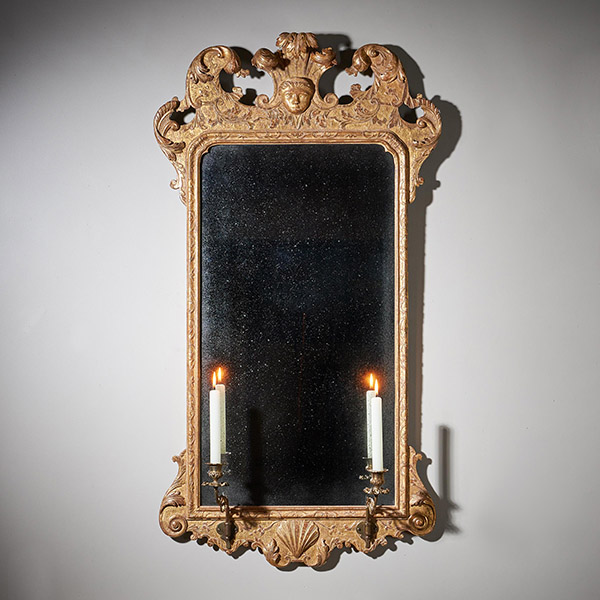
Fine 18th Century George I Gilt Gesso Pier or Console Mirror, Manner of Belchier
Fine 18th Century George I Gilt Gesso Pier or Console Mirror, Manner of Belchier £13,900Follow UsFine 18th Century George I Gilt Gesso Pier or Console Mirror, Manner of Belchier A fine and rare early 18th century George I Gilt Gesso pier or...
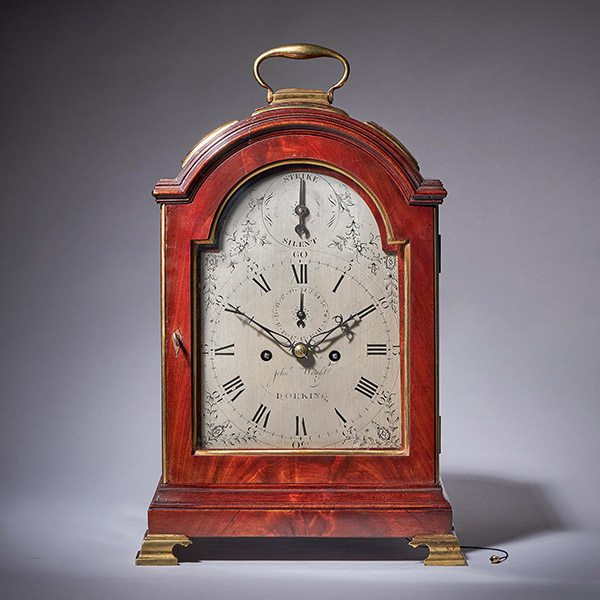
18th Century George III Figured Mahogany Three Pad Striking Bracket Clock
18th Century George III Figured Mahogany Three Pad Striking Bracket Clock £7,900Follow Us18th Century George III Figured Mahogany Three Pad Striking Bracket Clock 18th Century George III Figured Mahogany Three Pad Bracket Clock by JOHN WRIGHT...

17th Century Lantern Alarm Clock by Johannes Quelch, Oxford
17th Century Lantern Alarm Clock by Johannes Quelch, Oxford £14,000Follow Us17th Century Lantern Alarm Clock by Johannes Quelch, Oxford An English 17th century lantern clock made of brass and iron, circa 1665-1670. The clock consists of going...

19th-Century Flame Mahogany Mantel Clock by BREGUET Raised by Lion Paw Feet
19th-Century Flame Mahogany Mantel Clock by BREGUET Raised by Lion Paw Feet £23,500Follow Us19th-Century Flame Mahogany Mantel Clock by BREGUET Raised by Lion Paw Feet EXTREMELY RARE MANTEL CLOCK WITH A FIGURED MAHOGANY-VENEERED CASE by A-L...

Unusual Pair of 18th Century George III Cherry Chairs, Chippendale Period
Unusual Pair of 18th Century George III Cherry Chairs, Chippendale Period £3,900Follow UsUnusual Pair of 18th Century George III Cherry Chairs, Chippendale Period A fabulous and rare pair of George III cherry wood chairs in original 'Country...

Unusual Ribbed Eight-Day Repeating Striking Gilt-Brass Gorge Case Carriage Clock
Unusual Ribbed Eight-Day Repeating Striking Gilt-Brass Gorge Case Carriage Clock £4,850Follow UsUnusual Ribbed Eight-Day Repeating Striking Gilt-Brass Gorge Case Carriage Clock CaseThe clock has a gilt-brass case which is a variation on the...

Fine 18th Century George I Gilt Gesso Pier or Console Mirror, Manner of Belchier
Fine 18th Century George I Gilt Gesso Pier or Console Mirror, Manner of Belchier £13,900Follow UsFine 18th Century George I Gilt Gesso Pier or Console Mirror, Manner of Belchier A fine and rare early 18th century George I Gilt Gesso pier or...

18th Century George III Figured Mahogany Three Pad Striking Bracket Clock
18th Century George III Figured Mahogany Three Pad Striking Bracket Clock £7,900Follow Us18th Century George III Figured Mahogany Three Pad Striking Bracket Clock 18th Century George III Figured Mahogany Three Pad Bracket Clock by JOHN WRIGHT...








